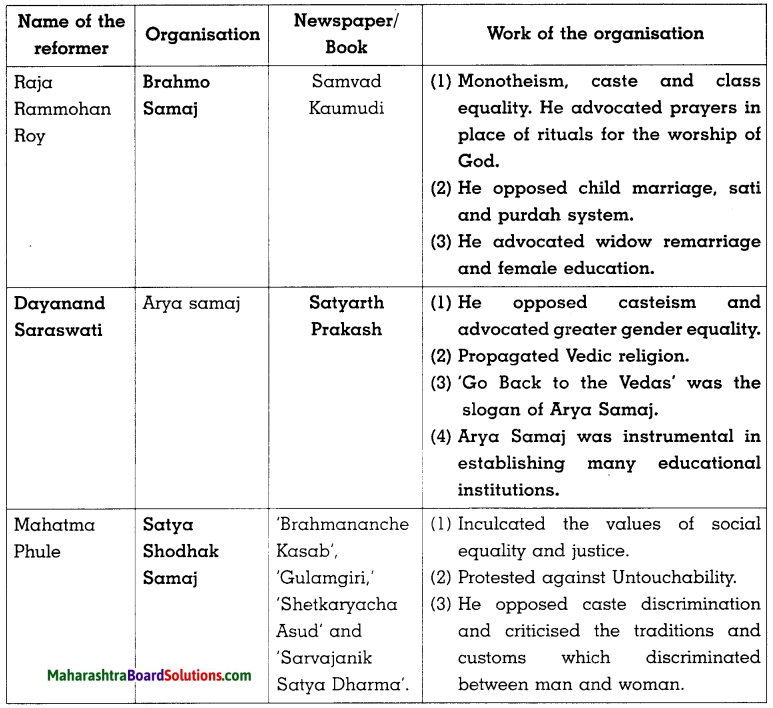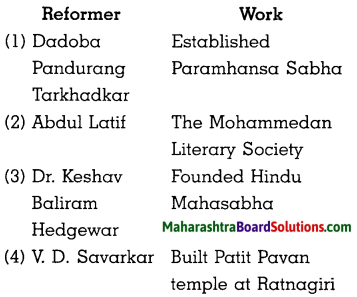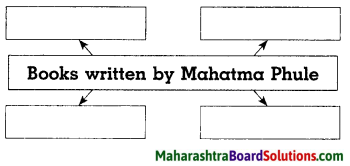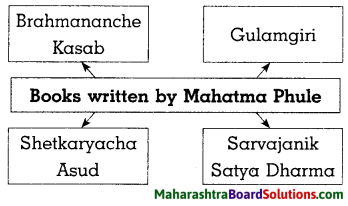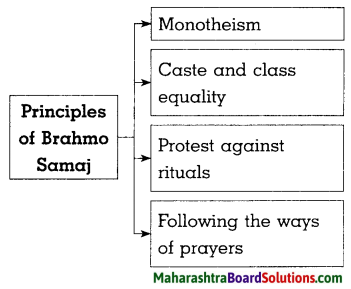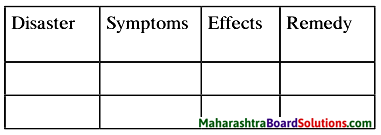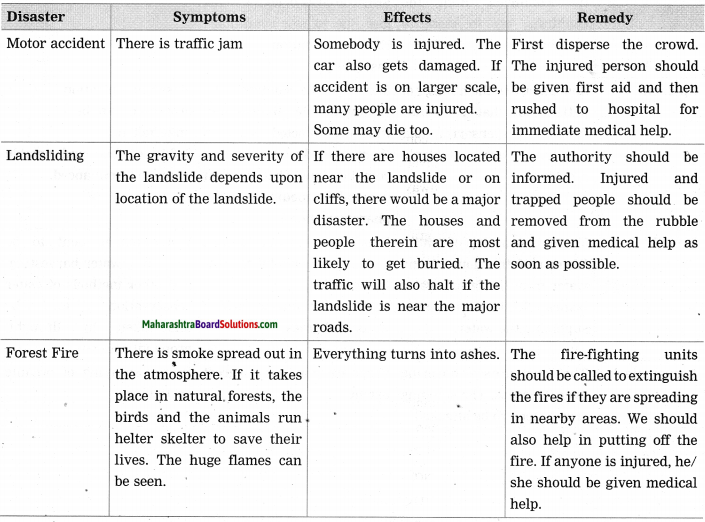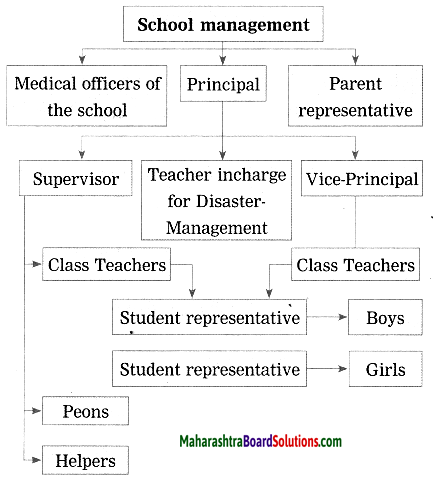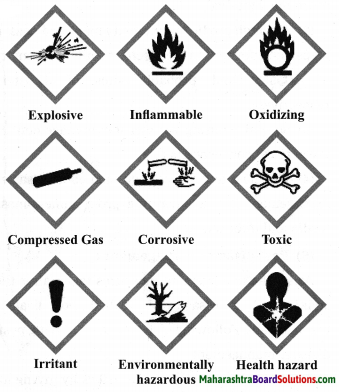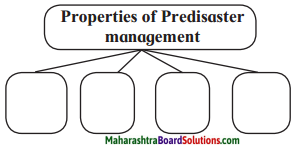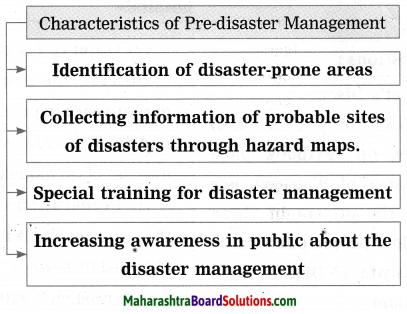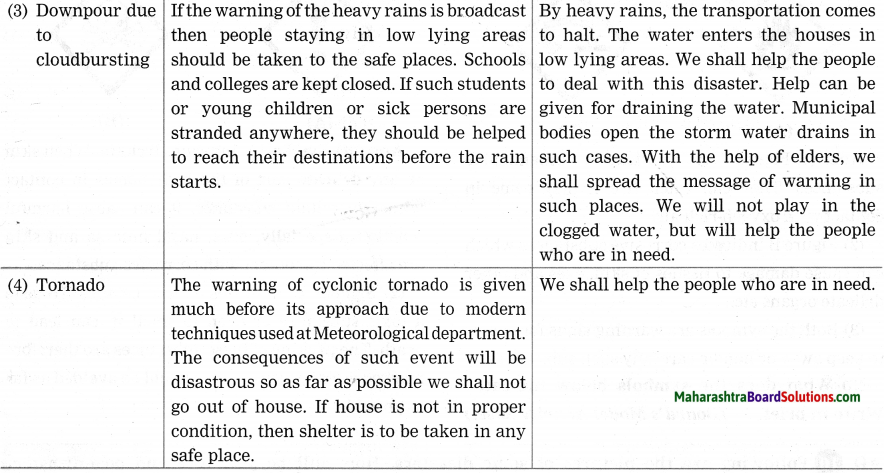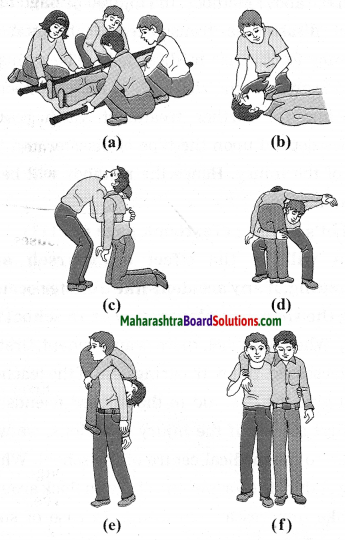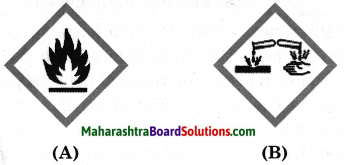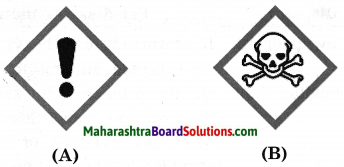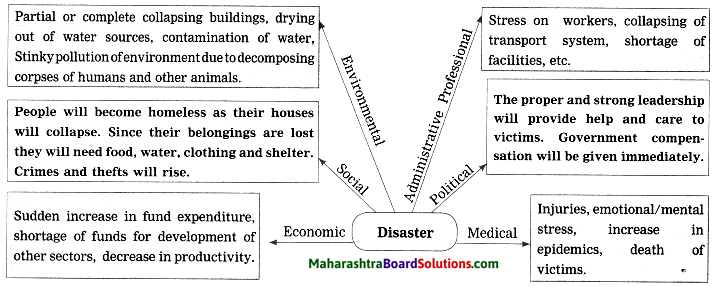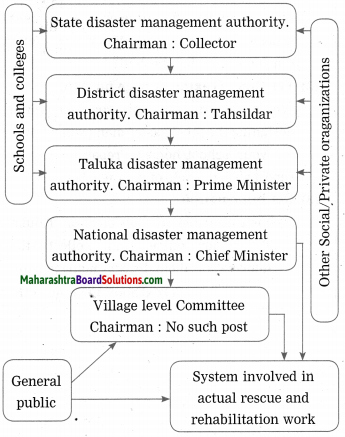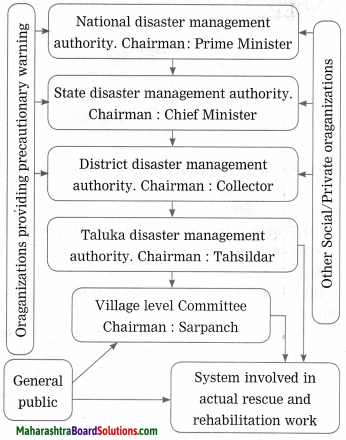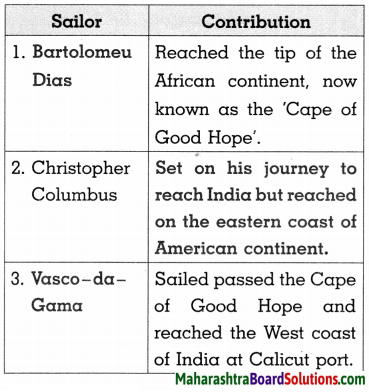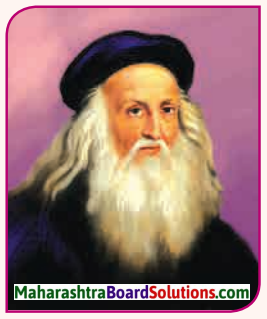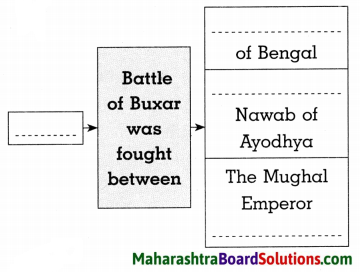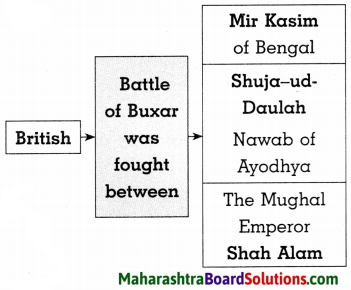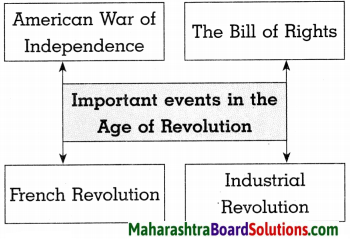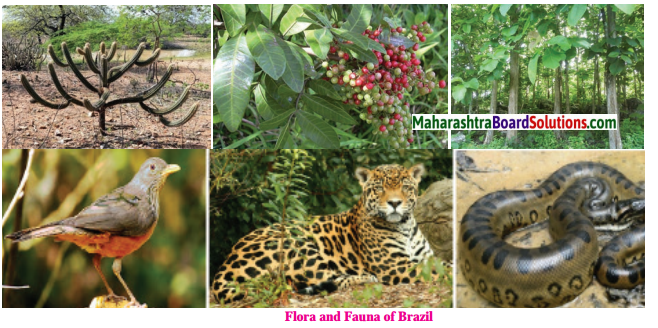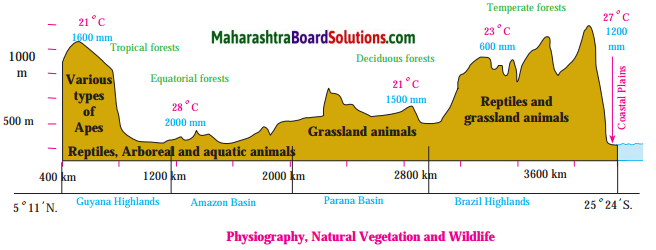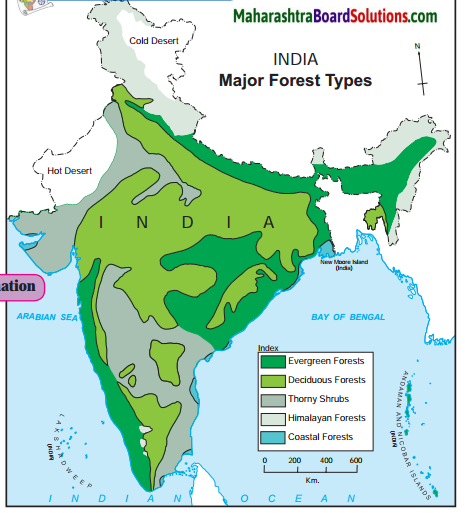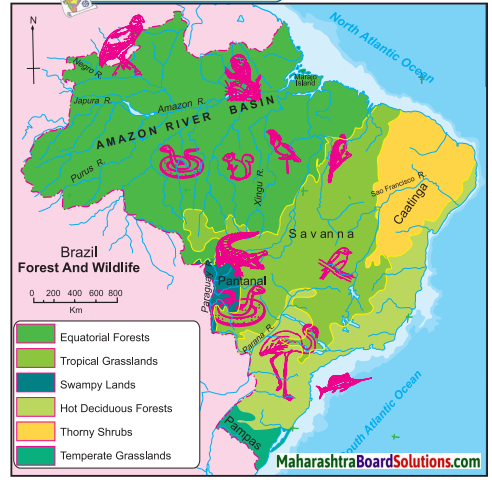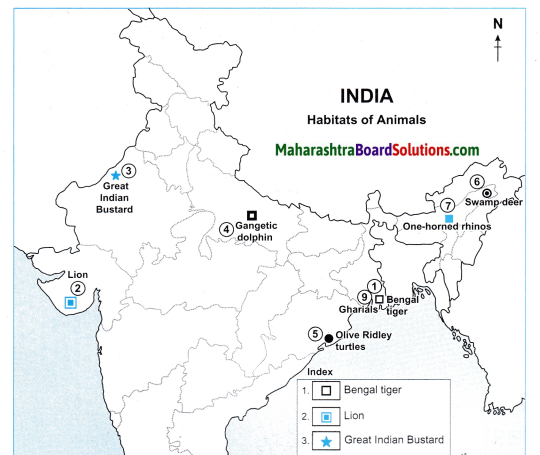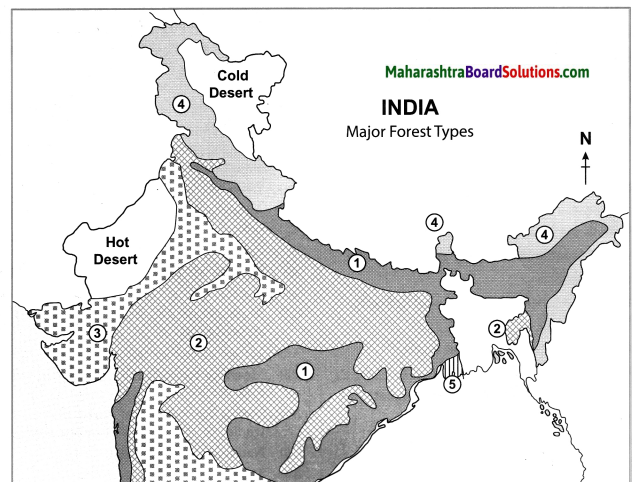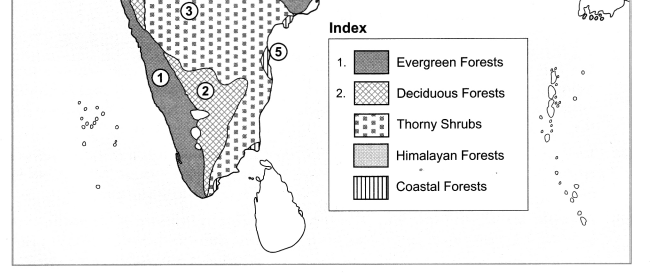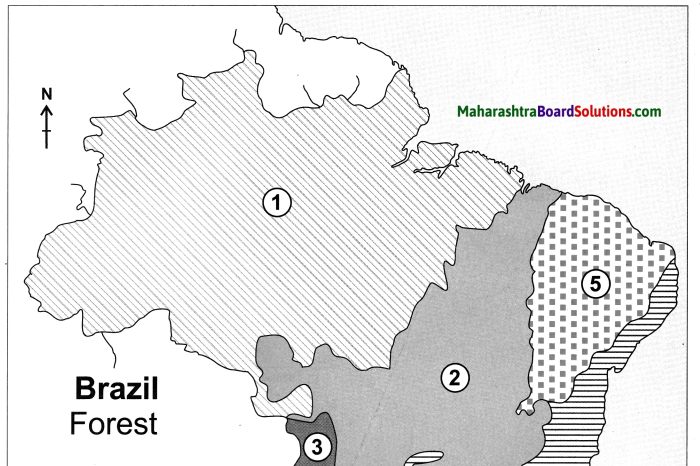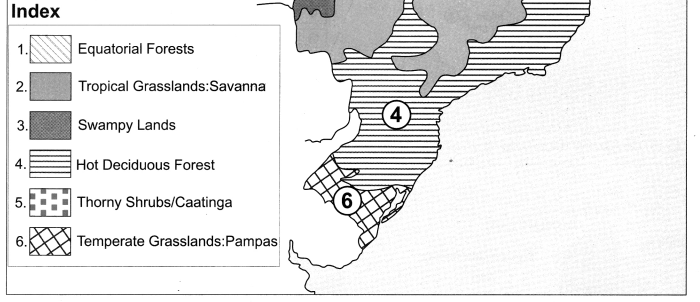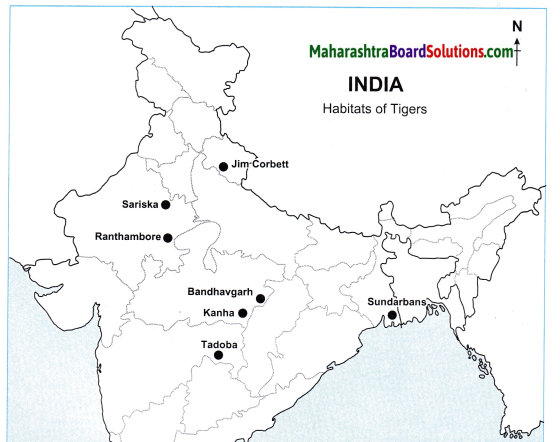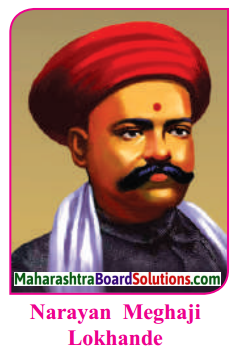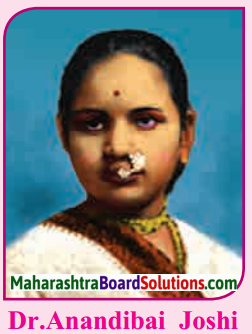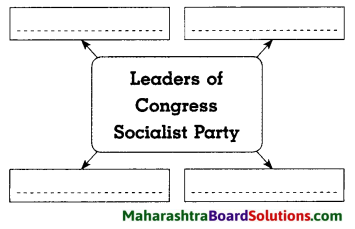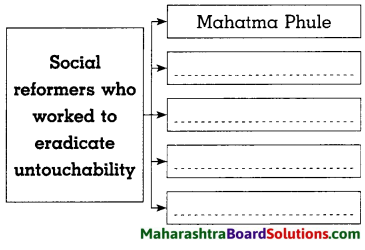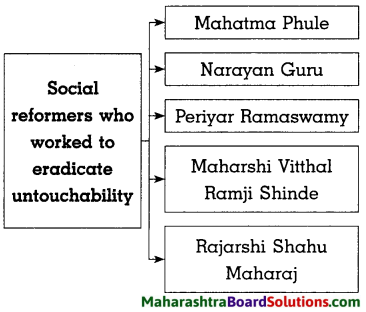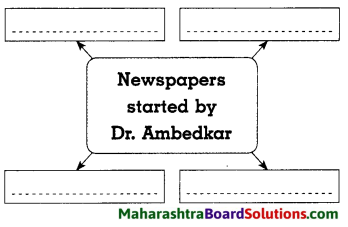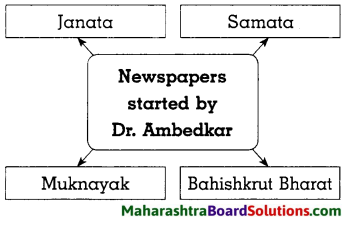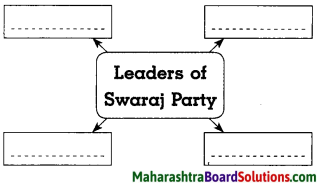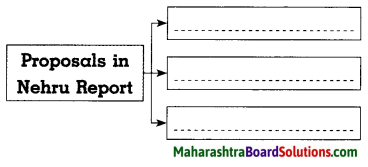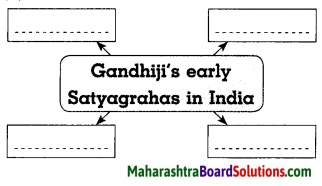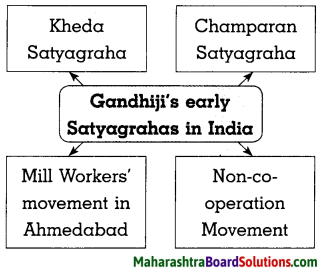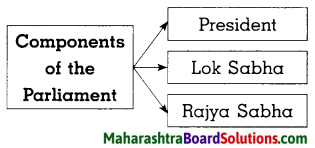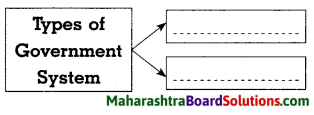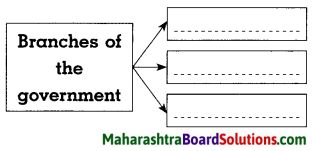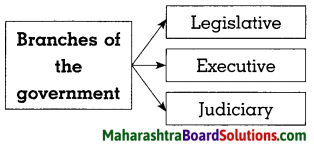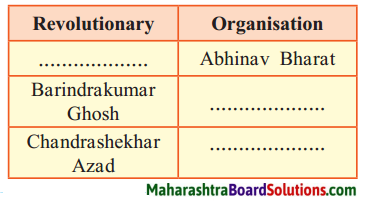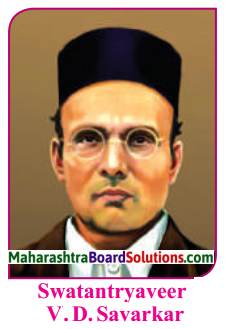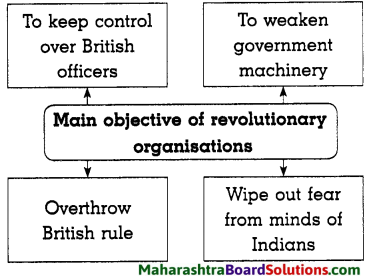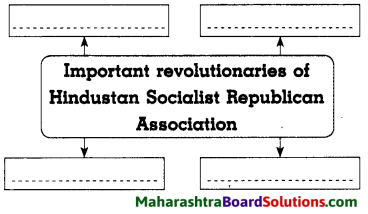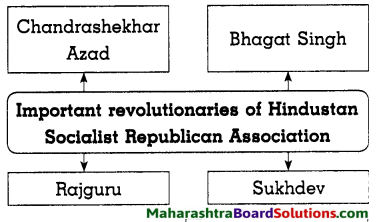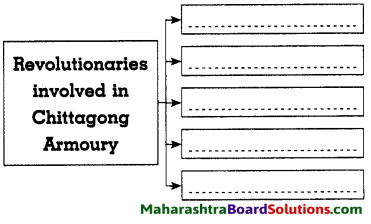Balbharti Maharashtra State Board Class 10 Geography Solutions Chapter 2 Location and Extent Notes, Textbook Exercise Important Questions and Answers.
Maharashtra State Board Class 10 Geography Solutions Chapter 2 Location and Extent
Class 10 Geography Chapter 2 Location and Extent Textbook Questions and Answers
1. Are the sentences right or wrong. ? Rewrite the wrong ones
Question a.
Brazil is mainly located in the Southern Hemisphere.
Answer:
Right
![]()
Question b.
Tropic of Capricorn passes through the middle of India.
Answer:
Wrong. Tropic of Cancer passes through the middle of India.
Question c.
The longitudinal extent of Brazil is less than India.
Answer:
Wrong. The longitudinal extent of Brazil is more than India.
Question d.
Equator passes through the northern part of Brazil.
Answer:
Right
Question e.
Brazil has a coastline along the Pacific Ocean.
Answer:
Wrong. Brazil has a coastline along the Atlantic. Ocean.
Question f.
Pakistan is a neighbouring country to the south east of India.
Answer:
Wrong. Pakistan is neighbouring a country to the north west of India.
Question g.
The southern part of India is called Peninsula.
Answer:
Right.
2. Answer in brief:
Question a.
What problems did Brazil and India face after independence?
Answer:
(i) India was under the British rule for almost one- and-a-half centuries and it got its independence in the year 1947.
(ii) It faced several problems like three wars, famine situations in various parts and similar issues after independence.
(iii) Brazil gained its independence in 1822 after more than three centuries of Portuguese rule.
(iv) From 1930 to 1985, for more than a half century, it was under a populist military government and it faced global financial difficulties in the late 20th century.
Thus, both India and Brazil faced many problems post-independence.
![]()
Question b.
How are Brazil and India different from each other in terms of location?
Answer:
(i) India is located in the northern hemisphere of the earth whereas some part of Brazil lies in the northern hemisphere and most of it lies in the southern hemisphere.
(ii) India entirely lies in the eastern hemisphere whereas, Brazil lies in the western hemisphere.
(iii) India lies in the continent of Asia whereas Brazil lies in the continent of South America.
(iv) India lies in the southern part of the continent of Asia whereas Brazil lies in the northern part of South American continent.
Question c.
Describe the latitudinal and longitudinal extent of India and Brazil.
Answer:
(i) The extent of the mainland India is 8°4’N to 37°6’N latitudes and between 68°7’E to 97°25’E longitudes.
(ii) Indira Point is the southernmost tip of India.
(iii) It is located on 6°45’N parallel.
(iv) The extent of the mainland Brazil is 5°15’N to 33°45′ S latitudes and between to 34°47’W to 73°48’W longitude.
Select the correct option
Question a.
India’s southernmost point is known as __________.
(a) Lakshadweep
(b) Kanyakumari
(c) Indira Point
(d) Port Blair
Answer:
(c) Indira Point
Question b.
These two countries in South America do not share their border with Brazil?
(a) Chile – Ecuador
(b) Argentina – Bolivia
(c) Columbia – French Guiana
(d) Surinam – Uruguay
Answer:
(a) Chile – Ecuador
Question c.
Both the countries have _________ type of government.
Military
(b) Republic
Communist
(d) Presidential
Answer:
(b) Republic
Question d.
Which of the following shapes show the coastal part of Brazil correctly?

Answer:

Question e.
Which of the following shapes show the coastal part of India Correctly?

Answer:

Question f.
Considering hemisphere, which shape correctly represents the hemisphere in which India lies?
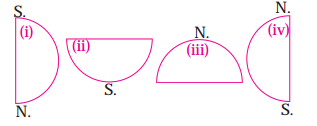
Answer:

Question g.
Considering the hemisphere, which correctly represents the hemisphere in which Brazil mainly lies?
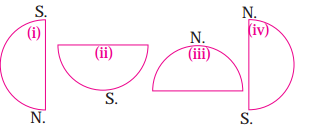
Answer:

Class 10 Geography Chapter 2 Location and Extent Intext Questions and Answers
Colours of both
Answer the following questions with respect to the countries that you have studied.
Question 1.
Out of the countries that you have coloured, which country is larger in size?
Answer:
Brazil is larger in size.
Question 2.
Which country has a larger latitudinal extent?
Answer:
Brazil has a larger latitudinal extent.
Question 3.
How do the locations of Brazil and India differ in terms of their positions in their respective continents?
Answer:
Brazil lies in the northern part of the continent of South America, whereas India lies in the southern part of the continent of Asia.
Question 4.
How many states does each of the two countries have?
Answer:
Brazil has 26 states and one federal district. India has 28 states and 8 union territories.
![]()
Question 5.
Obtain information regarding the emblems of both the countries, i.e. India and Brazil.
Answer:
India:
The national emblem of India is an adaptation of the Lion capital of Ashoka at Sarnath. The emblem has three lions visible, the fourth being hidden from the view. The four lions symbolise power, courage, confidence and pride. At the bottom is a horse and a bull, and its centre is a wheel (Dharma Chakra). Forming an integral part of the emblem is the motto inscribed in Devanagari Script: Satyameva Jayate (Truth Alone Triumphs)
Brazil:
The national emblem of Brazil is coat of arms shows the Southern cross in a blue circle. The ring of 27 stars around it represents Brazil’s 26 states and the Federal District. The whole is placed on a star and surrounded by coffee (at the left) and tobacco (at the right), which are the important crops in Brazil. The blue ribbon contains the official name of Brazil (Republica Federativa Do Brazil – Federative Republic of Brazil) in the first line. In the second, the date of the federative republic’s establishment (November 15, 1889) is written.
Give it a try.
Question 1.
The imperial power which ruled Brazil also ruled a part of India. Find out when that part of India achieved independence?
Answer:
Answer: In India, Goa, Diu and Daman, Dadra and Nagar Haveli were under Portuguese rule. These regions got independence on 19th December 1961.
Match the column:
Question 1.
| Column ‘A’ | Column ‘B’ |
| (1) Dance form of Brazil
(2) Capital of India (3) Capital of Brazil (4) Coffee pot of world |
(a) Brazil
(b) Samba (c) New Delhi (d) Brasilia (e) Bangladesh (f) Myanmar |
Answer:
1 – b
2 – c
3 – d
4 – a
Question 2.
| Column ‘A’ | Column ‘B’ |
| (1) Country to the south of Brazil | (a) China |
| (2) Sea to the west of India | (b) Uruguay |
| (3) Second largest populated country | (c) Arabian sea |
| (4) Coffee pot of the world Imperial power ruled Brazil | (d) India |
| (e) Portuguese | |
| (f) Japan |
Answer:
1 – b
2 – c
3 – d
4 – e
Answer the following questions in one sentence:
Question 1.
Which is the second largest populated country in the world?
Answer:
India is the second-largest populated country in the world.
Question 2.
Which country is called the ‘coffee pot’ of the world’?
Answer:
Brazil is called the coffee pot of the world.
Question 3.
Which dance form is famous in Brazil?
Answer:
Samba is the famous dance form of Brazil.
Question 4.
Name the capital of India?
Answer:
The capital of India is New Delhi.
Question 5.
When did India gain Independence?
Answer:
India got independence on 15th August 1947.
Question 6.
When did Brazil gain independence?
Answer:
Brazil gained its independence on 7th September 1822.
Question 7.
Which countries are located to the north of Brazil?
Answer:
Venezuela, Guyana, Suriname and French Guiana are situated to the north of Brazil
Question 8.
Which countries are located to the west of Brazil?
Answer:
Colombia, Peru, Bolivia, Paraguay and Argentina are situated to the west of Brazil.
Question 9.
Which country is situated to the south of Brazil?
Answer:
Uruguay is situated to the south of Brazil.
![]()
Question 10.
Which ocean lies to the east of Brazil?
Answer:
The North and South Atlantic Ocean lies to the east of Brazil.
Question 11.
Which countries are situated to the east of India?
Answer:
Myanmar and Bangladesh are situated to the east of India.
Question 12.
Which countries are situated to the north of India?
Answer:
China, Bhutan and Nepal are situated to the north of India.
Question 13.
Which sea lies to the west of India?
Answer:
Arabian sea lies to the west of India.
Question 14.
Which countries lie to the south of India?
Answer:
Srilanka, Maldives and Indonesia lie to the south of India.
Question 15.
What is the location of the southernmost tip of India?
Answer:
The location of the southernmost tip of India (Indira Point) is 6°45′ N parallel.
Question 16.
According to the equator, in which hemisphere is Brazil located?
Answer:
Some part of Brazil lies in the northern hemisphere, while most of it lies in the southern hemisphere.
Question 17.
In which hemispheres is India located?
Answer:
India is located in the northern and eastern hemispheres.
Question 18.
What type of government does Brazil have today?
Answer:
Today, Brazil has Federal Presidential Republic type of government.
Question 19.
What type of government does India have today?
Answer:
Today, India has Federal Parliamentary Republic type of government.
Question 20.
Where does the name Brazil come from?
Answer:
The name Brazil comes from ‘Pau Brasil’, a local wooded tree.
Question 21.
Who established the early settlement in Brazil?
Answer:
The Portuguese settlers established the early settlement in Brazil.
Question 22.
Distinguish between: Location of India and Brazil
Answer:
| India | Brazil |
| (i) India is located at 8°4’N to 37°6’N latitude and between 68°7’E to 97°25’E longitudes. | (i) Brazil is located at 5°15’N to 33°45’S latitudes and between 34°47’W to 73°48’W. |
| (ii) It is located in the northern and eastern hemispheres. | (ii) Some part of Brazil lies in the northern hemisphere, while most of it lies in the southern hemisphere. Brazil also lies in the western hemisphere. |
| (iii) India is located in the southern part of the Asian continent. | (iii) Brazil is located in the northern part of South American continent. |
Question 23.
Find the difference between the post-independence characteristics of India and Brazil.
Answer:
| Brazil | India |
| (i) Brazil gained its independence in 1822. From 1930 to 1985, for more than half a century, it was under a populist military government. Presently, Brazil has Federal Presidential Republic type of government | (i) India got its independence in the year 1947. It has Federal Parliamentary Republic type of government. |
| (ii) The proportion of older people that is non – working population is high.
|
(ii) The proportion of youth, i.e. working population is high.
|
| (iii )It has overcome global financial difficulties in the late 20th century | (iii) It has faced several problems like three wars, famine situations in various parts and similar issues after independence.
|
| (iv) Sex ratio and literacy rate is high in Brazil.
|
(iv) Sex ratio and literacy rate is low in India.
|
![]()
Observe the map and answer the following questions.
Question 1.
Identify the countries and water bodies around India and complete the following table.
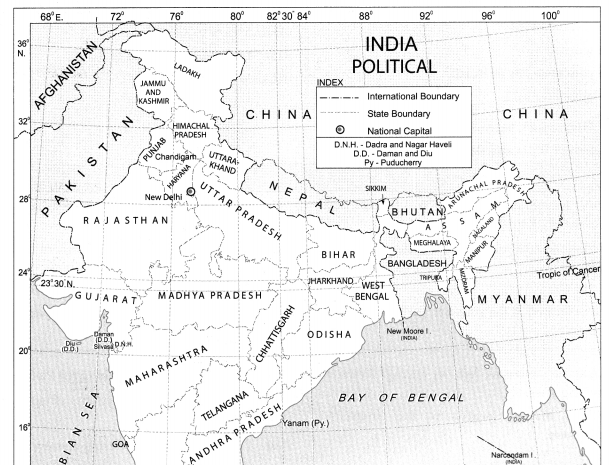
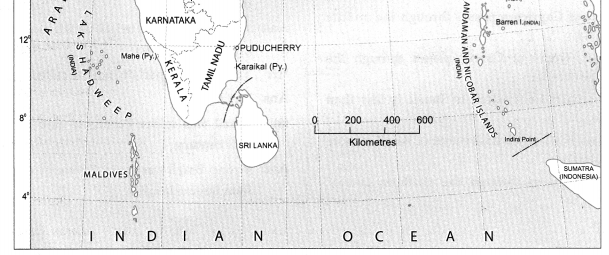
To the North
To the East
To the South
To the West
Answer:
| No. | Directions | Neighbouring Countries/ Oceans |
| (1) | North | China, Bhutan, Nepal |
| (2) | South | Indian Ocean, Sri Lanka, Maldives, Indonesia |
| (3) | East | Myanmar, Bangladesh, Bay of Bengal |
| (4) | West | Arabian Sea, Pakistan, Afghanistan |
Question 2.
Identify Brazil’s neighbouring countries and oceans. Complete the following table.
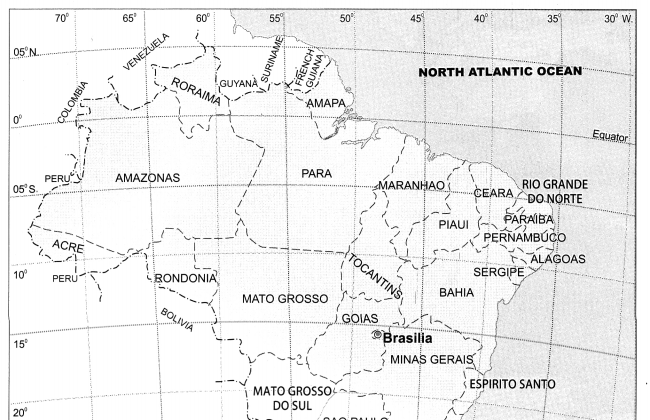

(a) To the North
(b) To the South
(c) To the East
(d) To the West
Answer:
| No. | Directions | Neighbouring Countries | Oceans |
| (1) | North | Venezuela, Guyana, Suriname, French Guiana | North Atlantic Ocean |
| (2) | South | Uruguay | South Atlantic Ocean |
| (3) | East | South Atlantic Ocean | |
| (4) | West | Peru, Bolivia, Paraguay, Colombia, Argentina |
Question 3.
Show the following on an outline of the world map.
(a) Name all the continents and oceans of the world.
(b) Colour Brazil and India using different colours and name them.
(c) Draw equator on the map and write its value in degrees.
(d) Show the symbol for direction.
Answer:
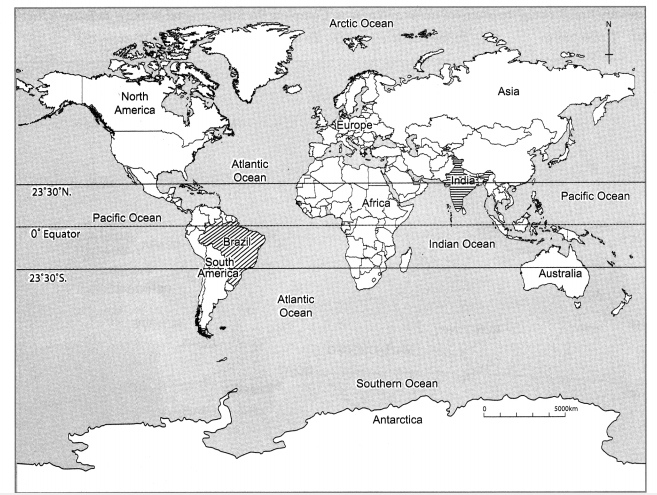
Give geographical reasons:
Question 1.
Brazil is called the ‘coffee pot of the world’.
Answer:
(i) Brazil ranks first in the world in the terms of production of coffee.
(ii) It produces nearly 40% of the total coffee production in the world.
(iii) It is the largest exporter of coffee.
Therefore, Brazil is called the ‘coffee pot of the world’.
![]()
Question 2.
Brazil is known as the country having third longest land border.
Answer:
(i) Brazil has the world’s third longest land border, after China and Russia.
(ii) It shares its boundaries with all South American countries, except Chile and Ecuador, totalling 16,885 Kilometers.
(iii) Brazil has borders with 10 different countries, which are Argentina, Bolivia, Colombia, French Guiana, Guyana, Paraguay, Peru, Suriname, Uruguay and Venezuela.
(iv) Hence, Brazil is called the country having third longest land borders.
Question 3.
India is looked upon as a young country.
Answer:
(i) The proportion of youth in India’s population is high.
(ii) This forms a major part of the working population.
(iii) According to 2011 census the percentage of working population is more than 50 %.
(iv) Hence, India is looked upon as a young country.
Question 4.
India’s economic development has paced up. OR India is considered as a major global market.
Answer:
(i) Despite facing several problems after independence, today India is a major developing country of the world.
(ii) It is because of various reforms from time to time, that India’s economic development has paced up.
(iii) So, it is considered to be a global market.
Answer in brief:
Question 1.
What problems did Brazil and India face after independence?
Answer:
(i) India was under the British rule for almost one-and-a-half centuries and it got its independence in the year 1947.
(ii) It faced several problems like three wars, famine situations in various parts and similar issues after independence.
(iii) Brazil gained its independence in 1822 after more than three centuries of Portuguese rule.
(iv) From 1930 to 1985, for more than a half century, it was under a populist military government and it faced global financial difficulties in the late 20th century.
Thus, both India and Brazil faced many problems post-independence.
Question 2.
How are Brazil and India different from each other in terms of location?
Answer:
(i) India is located in the northern hemisphere of the earth whereas some part of Brazil lies in the northern hemisphere and most of it lies in the southern hemisphere.
(ii) India entirely lies in the eastern hemisphere whereas, Brazil lies in the western hemisphere.
(iii) India lies in the continent of Asia whereas Brazil lies in the continent of South America.
(iv) India lies in the southern part of the continent of Asia whereas Brazil lies in the northern part of South American continent.
Question 3.
Describe the latitudinal and longitudinal extent of India and Brazil.
Answer:
(i) The extent of the mainland India is 8°4’N to 37°6’N latitudes and between 68°7’E to 97°25’E longitudes.
(ii) Indira Point is the southernmost tip of India.
(iii) It is located on 6°45’N parallel.
(iv) The extent of the mainland Brazil is 5°15’N to 33°45′ S latitudes and between to 34°47’W to 73°48’W longitude.
Class 10 Geography Chapter 2 Location and Extent Additional Important Questions and Answers
Name the following:
Question 1.
The second-largest populated country in the world.
Answer:
India
Question 2.
The country is famous for its spices in the world.
Answer:
India
Question 3.
The country is known as the ‘coffee pot’ of the world.
Answer:
Brazil
Question 4.
The famous dance form of Brazil.
Answer:
Samba
Question 5.
Hemispheres in which India is located.
Answer:
Northern and eastern hemispheres.
Question 6.
A continent in which India is located.
Answer:
Asia
Question 7.
The latitudinal extent of India.
Answer:
8°4’N to 37°6’N
Question 8.
The longitudinal extent of India.
Answer:
68°7’E to 97°25’E
Question 8.
Foreign power which ruled Brazil for more than three centuries.
Answer:
Portuguese.
Question 9.
Independence day of Brazil.
Answer:
7th September 1822.
Question 10.
Type of Government in Brazil from 1930 to 1985.
Answer:
Populist Military Government.
![]()
Question 11.
The latitudinal extent of Brazil.
Answer:
5°15’N to 33°45’S.
Question 12.
The longitudinal extent of Brazil.
Answer:
34°47’W to 73°48’W
Choose the correct option and rewrite the statements:
Question 1.
The second largest populated country in the world is _________.
(a) China
(b) Brazil
(c) India
(d) Russia
Answer:
(c) India
Question 2.
Brazil is famous for ________ type of dance form.
(a) Salsa
(b) Samba
(c) Ballet
(d) Tango
Answer:
(b) Samba
Question 3.
The country known as the ‘coffee pot’ of the world is _______.
(a) Brazil
(b) India
(c) China
(d) Pakistan
Answer:
(a) Brazil
Question 4.
India is located in the ________ part of the Asian continent.
(a) southern
(b) northern
(c) northeastern
(d) western
Answer:
(a) southern
Question 5.
Brazil gained independence in _______.
(a) 1890
(b) 1980
(c) 1822
(d) 1820
Answer:
(c) 1822
Question 6.
Capital of Brazil is _______.
(a) Kabul
(b) Kaula Lumpur
(c) Brasilia
(d) Monaco
Answer:
(c) Brasilia
Question 7.
Capital of India is _____.
(a) Patna
(b) New Delhi
(c) Dispur
(d) Chandigarh
Answer:
(b) New Delhi
Question 8.
India was under ___ rule for almost one and a half-century.
(a) Portuguese
(b) African
(c) Russian
(d) British
Answer:
(d) British
Question 9.
For more than a half-century, Brazil was under a _____ government.
(a) Populist military
(b) Monarchy
(c) Constitutional government
(d) Dictatorial
(a) Populist military
Question 10.
Most part of the of mainland Brazil lies in the ______ hemisphere.
(a) northern
(b) southern
(c) eastern
(d) northwestern
Answer:
(b) southern
Question 11.
Brazil was ruled by ______ imperial power which also ruled a part of India.
(a) Portuguese
(b) British
(c) Indonesia
(d) Pakistan
Answer:
(a) Portuguese

